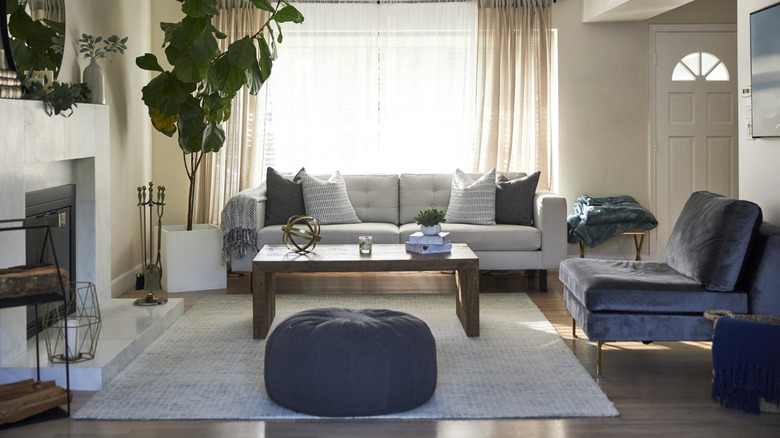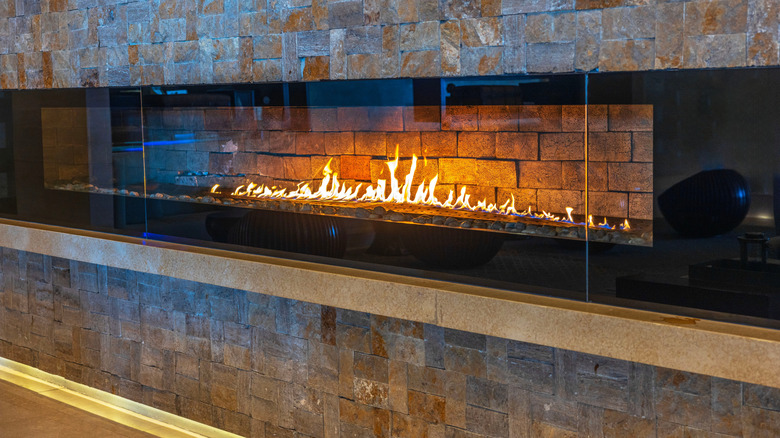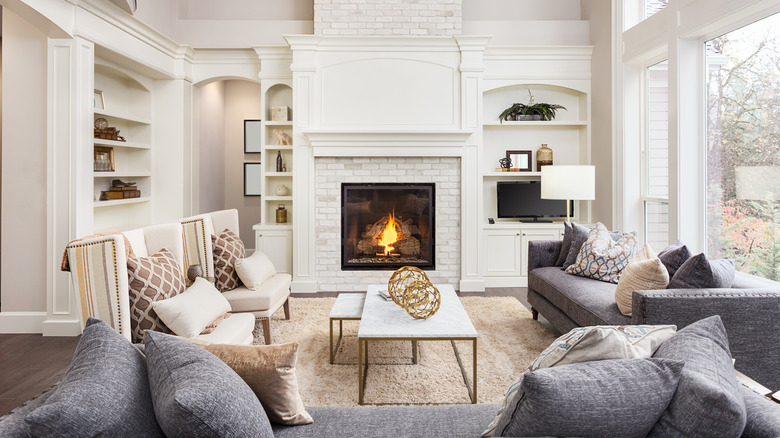The Trend That Is Dating Your Living Room According To Designers
Putting wall-mounted flat-screen TVs over the fireplace has become such a go-to design trend that people have largely forgotten that TVs used to be ornate furniture pieces in their own right. Likewise, fireplace mantels were the stuff that family photos, not TVs, sat on. Over the course of time, as the flat-screened TVs have gotten bigger, fireplace mantels have gone from hulky, to, if not lilliputian, at least a much smaller size. This is so much the case that rooms that still feature those monstrously oversized traditional fireplace mantels look tired, outdated even, like something you'd see on reruns of classic shows from the '70s and '80s, like "Dallas" or "The Six Million Dollar Man."
So what's the solution to this dilemma? For the modern flat-screened TV owner, there are other fireplace mantel choices that make more sense than these outdated stone fireplace designs. Mantels that are lower to the ground and less bulky than more traditional mantels come to mind. This design choice allows you to place the TV above the fireplace at a more comfortable height.
Here's a good rule of thumb. Sans fireplace, the ideal height for your TV is around 26 inches to 27 inches off the floor, with the middle of the TV, or eye level, being 40 inches off the floor. The average height for a fireplace mantel is around 54 inches to 60 inches above the floor. As such, you may want to think about lowering the mantel's height so that it aligns with those measurements. It's also wise to explore different fireplace and mantel designs because a change in one often necessitates a change in the other.
Designs that work better for the TV/ fireplace combo
For many fireplace owners, traditional stone or brick mantels have gone the way of the Dodo, as have traditional fireplace designs. There's almost no way around this problem unless you reconsider the design of both the fireplace and the mantel that sits on top of it. Linear fireplaces, for example, are wider than they are tall and usually sit about 12 inches to 36 inches off the floor. If you work on the lower end of those parameters, you could add a small floating mantel as a visual counterweight between a linear fireplace and the TV.
The design of the fireplace also allows you to lower the height of the mantel so that the TV hangs at a more comfortable height for the space and for TV-viewing. It additionally alleviates some of the restrictions that a frame-style fireplace can introduce into a design problem like this one. Floating mantels range in length, width, and height, with some of them being little more than a shelf inserted into the wall above the fireplace – something that would accommodate the TV/ fireplace combo well.
Or if your fireplace boasts a more traditional design, consider looking at a custom-designed mantel. This permits you to work within the parameters of the room's architectural elements, and can include space allowances for the TV. Ideally, you can design a mantel that allows the bottom of the TV to hang 3 inches to 4 inches above the top of the mantel. If you don't have that kind of clearance between the mantel and the TV, it could interfere with your view of the TV.
What to do instead of the TV/ fireplace combo
If you're lucky enough to have a new-build home, the problems caused by the TV/ fireplace combo might have already been solved for you with a creative fireplace makeover. For example, your abode might feature a mantel that's already both slimmer and shorter than older mantel/ fireplace set-ups. This arrangement means that the TV will sit lower. You'll avoid neck strain with this arrangement. However, the television still competes with the fireplace for focal dominance, which is one reason why this combo is problematic for many designers.
A better option for correcting the problem rethinks the design of the space by moving the TV from directly above the fireplace. One solution could be a faux fireplace mantel that serves as housing for a flat-screen TV. In other words, instead of having a fireplace below the mantel, you build a false mantel and place your TV inside of it where the firebox normally is. This solution also means that you'll still have some mantel space to decorate without the design dilemma caused by the fireplace/ mantel combo.
Or, you could embrace a design that features an asymmetrical placement of the TV with the fireplace. This allows you to put the TV and the fireplace on opposite sides of the same wall or even on opposite walls altogether. In both cases, a mantel can be a part of the architectural design of the room, leaving you with plenty of space to decorate a fireplace like a professional. And if you still love those big, bulky mantels of old, this design tactic allows you to embrace this classical style.


